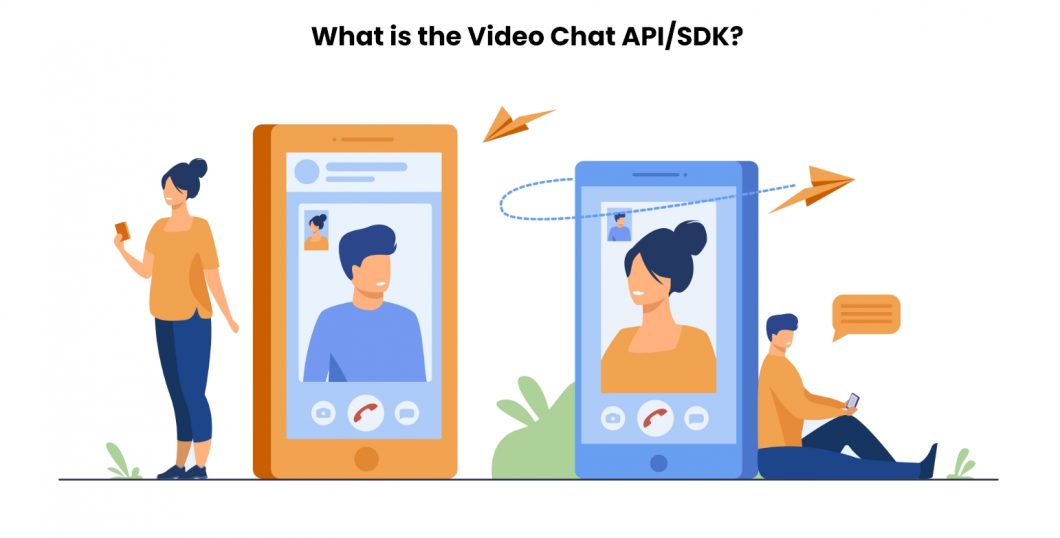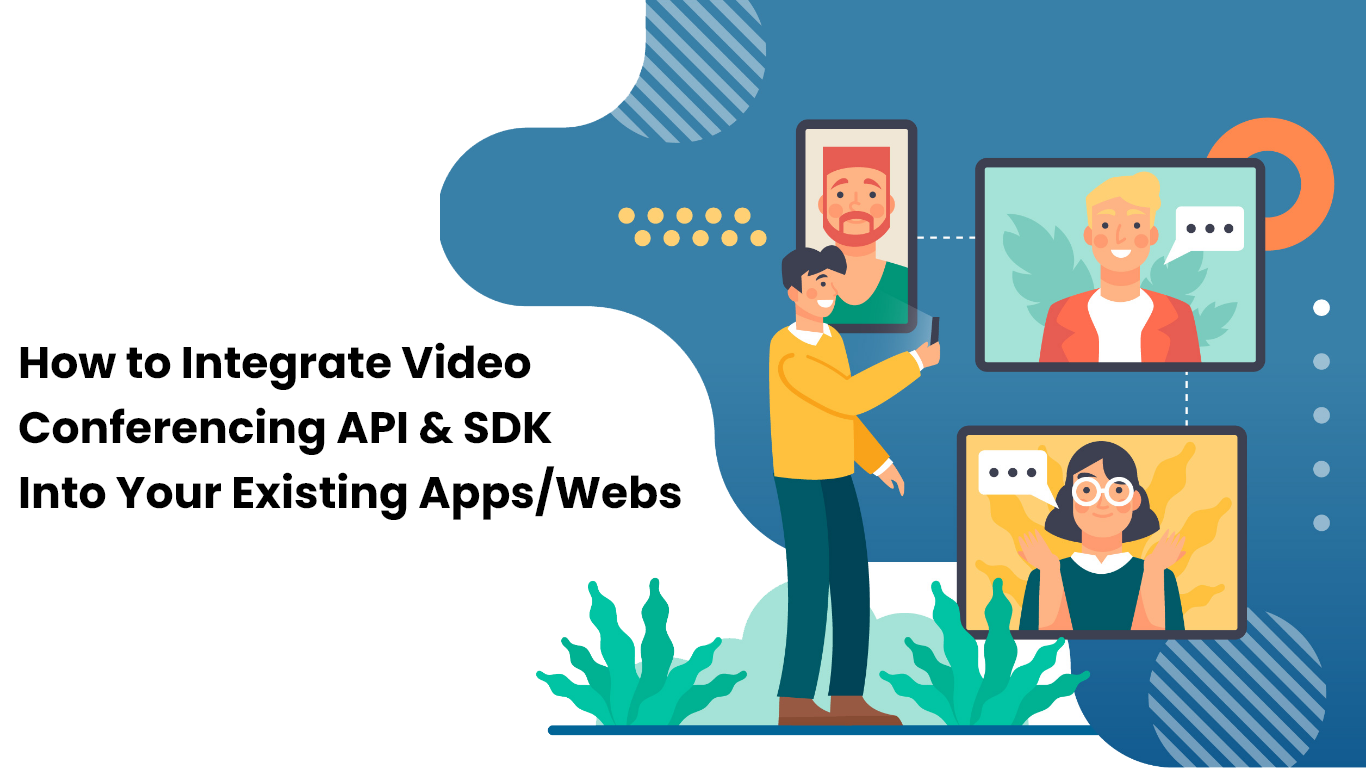The demand for virtual connection via audio/video chats and mobile applications is now greater than ever! All types of communication, from private conversations with friends/relatives to student-educator interaction, doctor consultations, and corporate meetings involving clients/employees, are taking place digitally, especially in light of the COVID-19 situation. And, thanks to its multiple benefits, this trend of communicating digitally is here to stay for a long time. As a result, including video conferencing API & SDK features in a mobile application will be a strategic decision for any mobile app developer.
Several companies have already started to utilize this feature in their apps in response to the current demand. Integration of video chat in mobile applications involves the use of a robust Video Conferencing API & SDK.
By 2025, the market for video communication will have grown from $1.7 billion to $2.5 billion.
The article provides an overview of the best video chat APIs to help you choose the best solution for your future app development project. Instead of depending on a third-party application, several firms have already developed their own video conferencing solution. Now is the time to get your company set up with an in-house or third-party video conferencing solution, which you can use in your app or on your website.
So let’s get started. But, before we go any further, let’s have a look at some of the most important elements of video chat APIs!
Table of Contents
- What is the Video Conferencing API & SDK?
- There are many potential elements in the market for Video Conferencing API & SDK, but a few of them include
- Benefits of Video Conferencing Integration
- Approaches we can follow to add video and audio calls in-app
- Companies can also select from the following options when building a video conferencing platform
- Challenges of Using Pre-built Video Conferencing Apps
- Challenges of Using Third-Party Video Conferencing Apps
- Examples of Video Conferencing Apps
- Summary
What is the Video Conferencing API & SDK?

A video-audio integration tool that allows a device to use real-time video chat is known as a Video Conferencing API & SDK. The API offers the technical framework for video communication. API stands for Application Programming Interface, and it allows various types of software to communicate and share data with others.
An SDK is a collection of software development kits that may be used to create a fully functional new app that can be simply integrated into any Android, iOS, or web application. Whether the SDK includes libraries, visual editors, debuggers, and APIs.
APIs/SDKs have the following important characteristics
- Various types of conferencing formats
- Messaging and voice capabilities are included.
- Recording and sharing your screen
Purpose and Benefits of Video Conferencing API & SDK for Your Business
When used correctly, video conferencing can be a powerful tool for any company. As a result, it’s important to train employees to use their unique online video conferencing APIs with video calling in Android, iOS, and website apps.
There are many potential elements in the market for Video Conferencing API & SDK, but a few of them include
1. Faster Time-To-Market
These APIs and SDKs make it easier to develop a cross-platform video conferencing software or video chat application since the APIs allow for rapid infrastructure and feature implementation.
2. Saving a Huge Amount of Resources
The enabled SDKs and API can help to build your video call app with exciting features and other capabilities instead of allowing your developers to spend time creating one particular chat functionality. Things get done faster with these APIs and SDKs, even with minimal resources (developers).
3. Video Conferencing and Screen Sharing
One-to-one video calls, group video conferencing, and mass or big conferencing, such as webinar broadcasts, are all possible.
4. Video & Audio Call Recording
A cloud-based recording tool that allows you to record live webinars and meetings in a safe environment and recover the recordings for future updates.
5. Real-time Messaging
This allows your users to communicate with one another in real-time using various communication methods.
Benefits of Video Conferencing Integration
1. Quick implementation
Using a video chat API for Android and iOS simplifies developing an app. This saves time and reduces the need to put business services and goals on hold to hire developers and designers.
2. Reduced costs
Using video chat software is less expensive than creating one from scratch. Businesses may pay a one-time fee and not have to worry about maintenance or customization fees in the future.
3. More security
Using an Android or iOS video chat SDK guarantees prioritizing security and privacy. This plug-and-play solution ensures customers can start quickly. Development and testing are already handled, so no extra safety precautions are needed. It simplifies the setup process significantly.
4. Added ML/ AI capabilities
Good video chat APIs and SDKs provide Machine Learning (ML) or Artificial Intelligence (AI) capabilities that power company processes without the need to create them from scratch. This also lowers the cost of employing skilled machine learning designers and engineers.
5. Saving travel expenses
Companies may save money on travel expenditures by using a video chat API or SDK for client or investor meetings in the same city or across the globe. In addition, video calls dramatically cut insurance and infrastructure costs.
6. Maintain business continuity
Using a video chat API or SDK allows organizations to continue operating as usual without having to divert valuable resources to developing an in-house app.

Approaches we can follow to add video and audio calls in-app
In-house Video Conferencing Apps:
- Cloud hosting: This allows multiple users to access your application without the requirement for in-house servers.
- In-house servers: Instead of being hosted in the cloud, the video SDKs are kept in-house.
Companies can also select from the following options when building a video conferencing platform
1. A peer-to-peer strategy: Systems are connected over the internet, and files may be exchanged without the need for a central server with this technique.
2. Using a media server: An application program preserves all digital media files while also making them available on demand through a network in this manner.
3. The CPaaS model: Adding real-time functionality to a cloud platform via a Communication-Platform-as-A-Service (CPaaS) provider eliminates the need to create backend interfaces or infrastructure.
Challenges of Using Pre-built Video Conferencing Apps
1. Customizing features is tough
Creating customizable features in video chat software is much more complex than it appears. These features will need to consider all teams and their needs and work smoothly even if new features are added over time.
2. It’s challenging to run it on your servers
Your servers or cloud service might not be able to handle your new video calling app. Even if you have custom-built servers, ensuring that they remain reliable during uploads and use will need much adjusting. Businesses may risk crashing servers and losing data if this is done wrong.
3. Communicate with built-in security and privacy
It isn’t enough for an organizational video app to rely exclusively on in-built security and privacy, as seen by the increasing number of incidents of privacy breaches and security failures. While this may be addressed by taking additional measures on the users’ part, it all adds up to a lengthy operation that might be avoided.
4. Costs can build up
Unlike other applications that charge one-time fees for SDKs and APIs, the expense of developing and maintaining custom-built video-calling apps may add up over time. The incremental costs of new features and upgrades may strain budgets considerably more than if firms paid a one-time fee.
It isn’t all doom and gloom, however. There is a method for businesses to benefit from the greatest custom-built video conferencing system without building it themselves. Using an SDK or API is the key to success.
Challenges of Using Third-Party Video Conferencing Apps
1. Data leakages
Investigators recently looked into a popular video conferencing software for allegedly leaking users’ personal information, including email addresses and pictures, in a data breach. Despite the popularity of the video call service, data theft and leaks can still occur and potentially bring the service down.
2. Defects in privacy
One of the most common security needs nowadays is end-to-end encryption. However, several popular third-party video conferencing programs have not entirely implemented E2E, resulting in a slew of privacy and security issues. A recent example was when a third-party program grouped users with the same email provider (such as Gmail and Yahoo!) into the same organizational structure, allowing strangers to communicate with one other. Social networking sites allegedly shared personal information to sell for ad targeting and other uses, all without user consent.
3. Assuring Service Quality
The best video conferencing software should be compatible with any device setup and network capacity. It must also transmit data quickly and be simple to use. Meeting all these requirements is challenging for developers. Addressing each concern with updates makes the program slow to secure and refine.
Also Read: WhatsApp Business API – All You Need To Know
Examples of Video Conferencing Apps
1. MirrorFly
MirrorFly’s White-label video conferencing SDK is a 100% customizable solution that comes with thousands of features, including unlimited HQ video calls, conferencing, broadcasting, screensharing & live streaming.
2. Vonage
Vonage provides flexible and scalable voice, messaging, video, and data capabilities across Unified Communications, Contact Centers, and Communications APIs.
3. Sinch
Connect with customers and make personal interactions with simple, customizable SMS, voice, video, and verification tools. Get additional details right now.
4. Zuji
Now is an end-to-end engagement solution that makes real-time conversation, live streaming, on-demand video, and content delivery networks easy to integrate into your app.
5. Video SDK. Live
With the help of Video SDK, you can include real-time audio and video APIs, live streaming APIs, and video-on-demand APIs in your application. Thousands of users are served.
6. EnableX
EnableX’s Communication APIs, Video Conferencing, and SaaS solutions provide smart, adaptable, and scalable phone, video, and messaging capabilities.
7. Eyes
on- Eyeson’s unique cloud-based API lets you combine live video, audio, and data into a single interface that integrates easily into any environment
8. Agora
The Real-Time Engagement Platform allows us to make meaningful human relationships in real time. When people see, hear, and interact with one another, they are more engaged. Agora will enable us to integrate rich speech and video in any application, device, and location.
9. CometChat
In CometChat, you can add real-time text, voice, and video chat to your app.
Summary
Video conferencing has grown more accessible in recent years. You’ll need an app to make or receive video calls. There are a variety of smartphone apps for this. Both audio and video inputs are sent between two or more end-users during video calling. Using the greatest API, you can create the best video-calling software. Several video chat APIs allow mobile apps to communicate in real-time (RTC).
Firms like PubNub, TokBox, Sinch, Quickblox, and Twilio offer source code that integrates seamlessly with third-party APIs such as WebRTC, RESTful, and JavaScript. WebRTC is the most difficult of the technologies for creating video chat apps. The majority of businesses provide the most comprehensive cross-platform communication solution.

